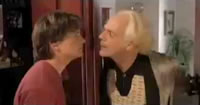 Why are Marty McFly and Doc Brown casting lingering glances at each other? Why is that hug between Maverick and Iceman lasting so long? It’s all part of the latest online phenomenon of Brokeback Spoofs. These creative online video mash-ups start with the music and title cards from the Brokeback Mountain trailer,
Why are Marty McFly and Doc Brown casting lingering glances at each other? Why is that hug between Maverick and Iceman lasting so long? It’s all part of the latest online phenomenon of Brokeback Spoofs. These creative online video mash-ups start with the music and title cards from the Brokeback Mountain trailer,  mix in clips from favorite movies like Top Gun, Star Wars, The Shawshank Redemption and presto! BrokeBack to the Future. Star Wars: The Empire Brokeback. The Brokeback Redemption. None of which, thankfully, are coming soon to a theater near you.
mix in clips from favorite movies like Top Gun, Star Wars, The Shawshank Redemption and presto! BrokeBack to the Future. Star Wars: The Empire Brokeback. The Brokeback Redemption. None of which, thankfully, are coming soon to a theater near you.
These Brokeback trailer parodies have recently risen to the level of journalistic analysis. A writer for the NY Times has devoted an article to this internet trend, claiming that “as a commentary on the forms and ceremonies of proto-gay relationships” these online shorts are “worth taking seriously.” The writer contends that these spoofs, while ostensibly comic in purpose, reveal the homosexual subtext lurking in our popular movies.
This type of critical theory is, of course, nothing new. The idea that same-sex relationships are necessarily overtly or covertly homosexual is rather entrenched in much of contemporary literary criticism and other academic circles. Participants in the relationship may be utterly oblivious to the fact, but ultimately unconscious homosexual longings are at the center of their friendship.
Now, to me, the humor in these Brokeback Spoofs stems from their parody of this queer theory (“Every movie you’ve ever seen is gay! Get it?”). But like the NY Times writer, I also believe the spoofs reveal a serious point: the poverty of same-sex friendships in contemporary society.
Login to read more
Sign in or create a free account to access Subscriber-only content.
Topics: